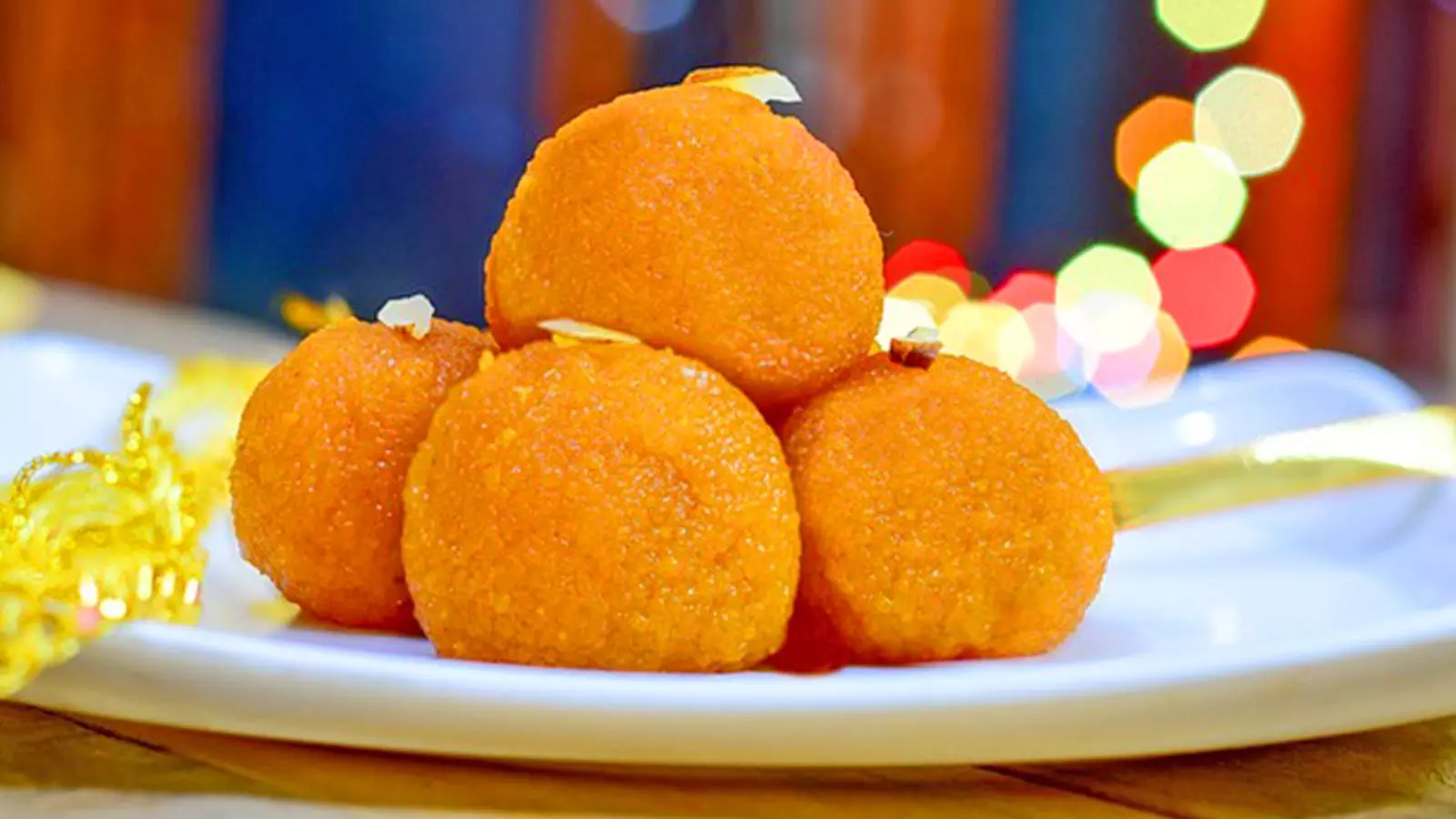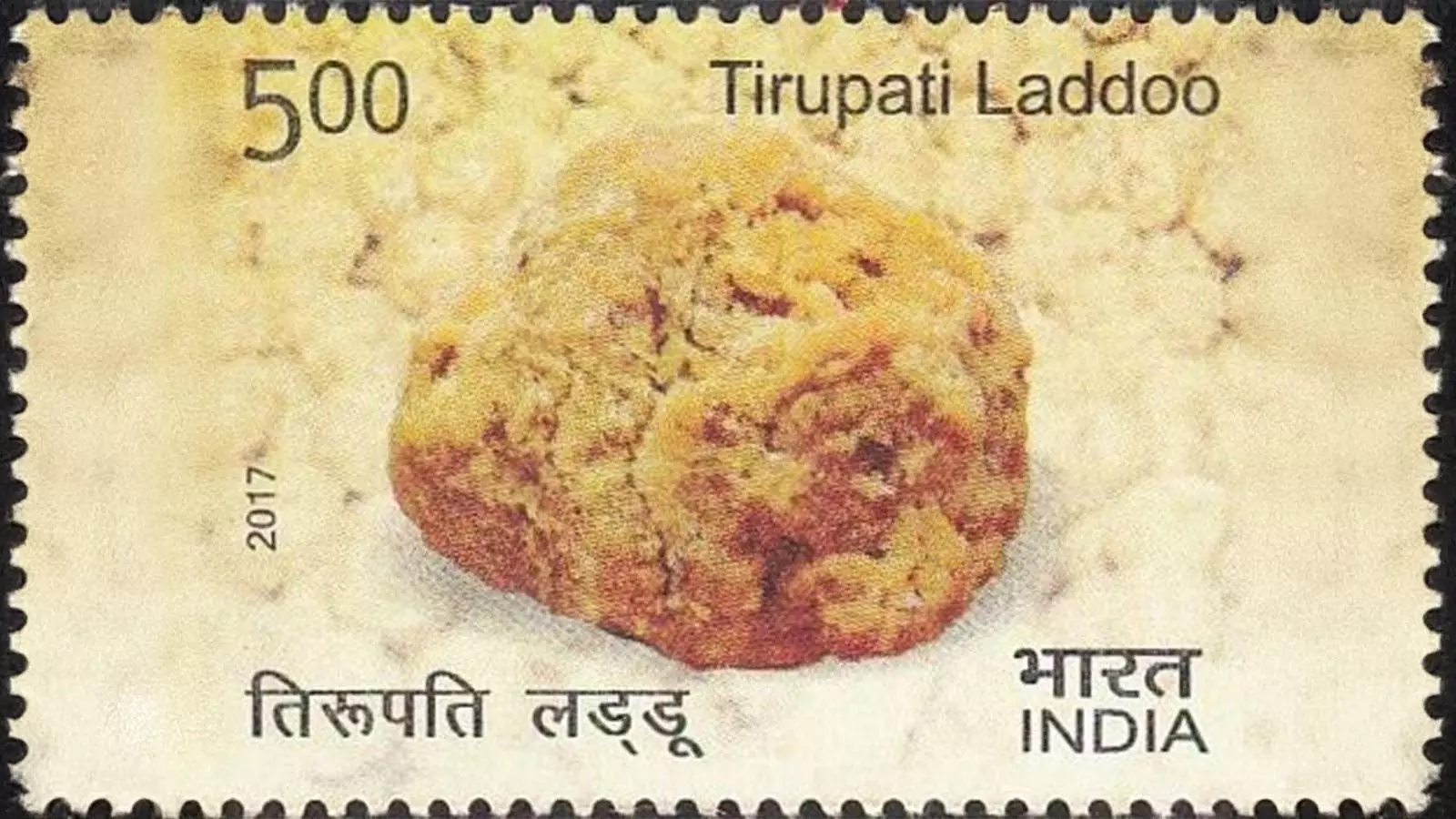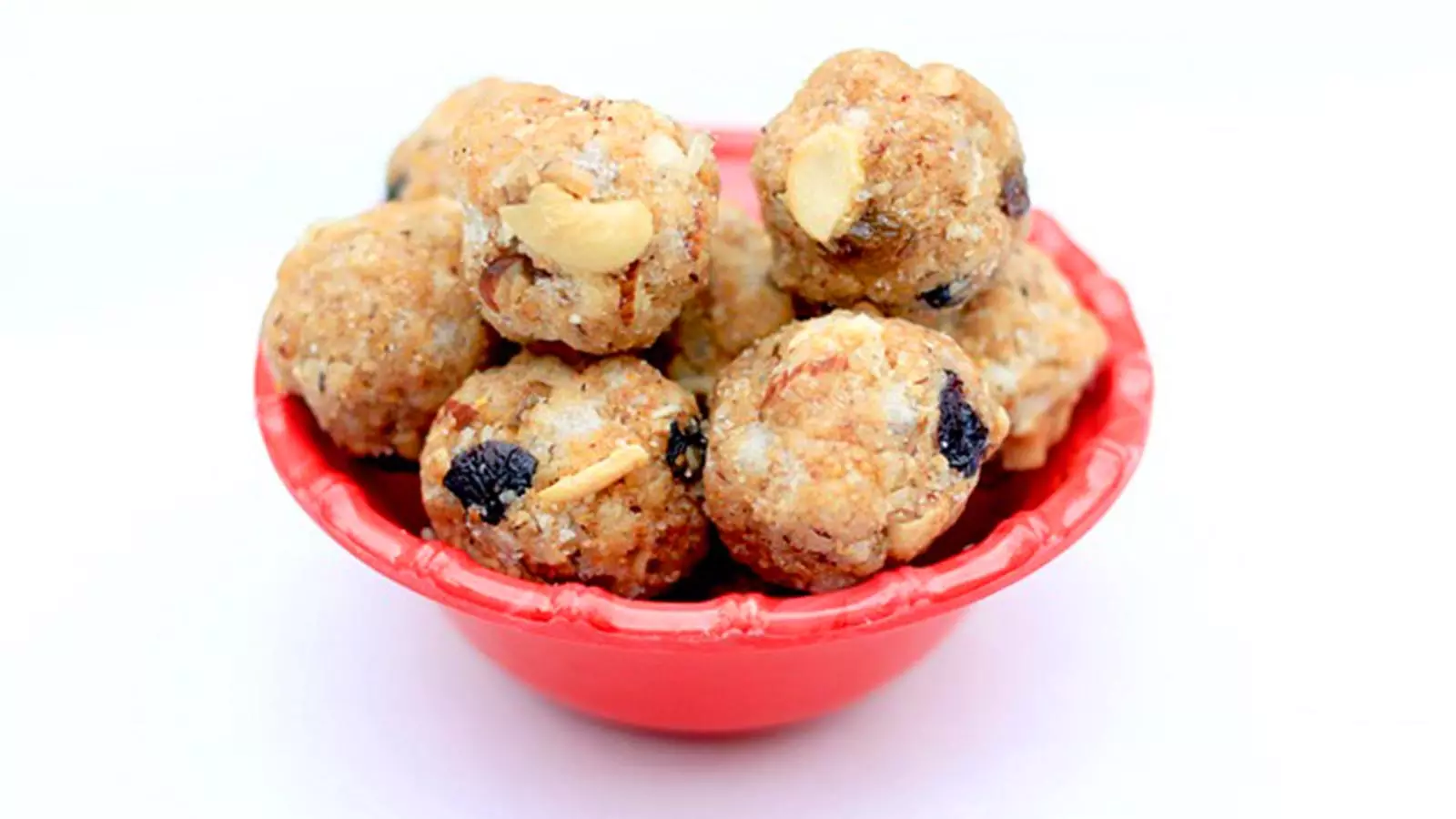
- Home
- India
- World
- Premium
- THE FEDERAL SPECIAL
- Analysis
- States
- Perspective
- Videos
- Sports
- Education
- Entertainment
- Elections
- Features
- Health
- Business
- Series
- In memoriam: Sheikh Mujibur Rahman
- Bishnoi's Men
- NEET TANGLE
- Economy Series
- Earth Day
- Kashmir’s Frozen Turbulence
- India@75
- The legend of Ramjanmabhoomi
- Liberalisation@30
- How to tame a dragon
- Celebrating biodiversity
- Farm Matters
- 50 days of solitude
- Bringing Migrants Home
- Budget 2020
- Jharkhand Votes
- The Federal Investigates
- The Federal Impact
- Vanishing Sand
- Gandhi @ 150
- Andhra Today
- Field report
- Operation Gulmarg
- Pandemic @1 Mn in India
- The Federal Year-End
- The Zero Year
- Science
- Brand studio
- Newsletter
- Elections 2024
- Events
Health ball to haute laddus: The delicious rise of India’s sweet rockstar

Long before it became the star of wedding trays, festive thalis, and celebratory occasions, India’s plump little ball of joy, the beloved laddu, was essentially Ayurveda’s answer to a protein bar—a ghee-soaked, herb-packed, jaggery-laced health booster. Tracing its birth to 3rd century CE Sushruta Samhita, the oldest and most authentic treatise on Ayurveda, it was designed to...
Long before it became the star of wedding trays, festive thalis, and celebratory occasions, India’s plump little ball of joy, the beloved laddu, was essentially Ayurveda’s answer to a protein bar—a ghee-soaked, herb-packed, jaggery-laced health booster. Tracing its birth to 3rd century CE Sushruta Samhita, the oldest and most authentic treatise on Ayurveda, it was designed to nourish: essentially a wellness bite of sesame, peanut, and jaggery, hand-rolled by vaidyas to boost immunity and vitality. In fact, Sushruta, the physician himself, used laddus as an antiseptic to treat patients of surgery.
Over time, as culinary traditions evolved and sugar sweet-talked its way into kitchens, these vintage edition health balls came to be ‘refined’ with cardamom, dry fruits, rosewater, musk, and more, until voila, the humble Ayurvedic fix morphed itself into the divine and delicious. The laddu, from the Sanskrit ladduka, meaning small ball, ditched its medicinal straightjacket, moving from mortar and pestle to temple altar, and medicine cabinet to celebration table—carrying with it taste, tradition, emotion, and a lot of cultural swaggers.

At Makhan Bhog, a sweetmeat outlet that old-timers in Guwahati frequent, laddus outsell even the peda, long favoured in most temples of eastern India. Says Sangita Arya, its proprietor, "laddus are the Number 1 selling sweet, especially on Tuesdays and Saturdays when devotees make offerings at temples."
Sweet as sacred
Temples, in fact, have played a large role in shaping the laddu’s legacy. Since the time they started sweetening faith with prasad/prasadam, these balls have practically become the gummy bears of worship. Across the country, during religious festivals, laddus are the unofficial mascot of divine blessings—favoured for their long shelf life and portability. Countless temples thus quietly roll out their versions of sacred balls, mostly made from whatever’s local—rava, coconut, sesame, gram flour, motichur, boondi.
Iconic among temple laddus is the Srivari laddu, which was first offered to the deity at Tirumala Venkateswara Temple in Andhra Pradesh in 1715. Over the centuries, the temple’s laddu potu or sacred kitchen—now humming with conveyor belts, massive vats of ghee, and over six hundred staff churning out 800,000-odd laddus a day—has not only finetuned it into a perfectly round globe but also earned a Geographical Indication (GI) tag to ward off imposters. Up north, Ayodhya’s Hanumangarhi Temple also blesses devotees with its region-specific, desi ghee GI‑tagged laddus—the tag acquired just before the historic consecration of the Ram Mandir in 2024. Lallan of Krishna Bhog Prasad, a sweet shop operating near the temple in Ayodhya since 1950, says, “The demand for desi-ghee laddus have shot up since the tag. Pedas now are poor second.”

In the west, at Mumbai’s Shree Siddhivinayak Temple, besan laddus are handed out like golden tickets to Lord Ganesha’s VIP lounge and in Ujjain in central India, the Mahakaleshwar Temple in Madhya Pradesh has even earned a five‑star FSSAI rating for hygiene and taste of its gram flour laddus. Over in Odisha in the east, even the Jagannath Temple in Puri adds a grainy sweetness to its famous ‘Chappan Bhog’ offering to the deity with laddus. And, at Hyderabad’s annual Khairatabad Ganesh Utsav, the maha laddu—a jaw-dropping, crane-lifted feat of spiritual engineering that is crafted with mountains of gram flour, jaggery, ghee, and unshakeable faith—is chopped up and handed out as prasadam after rites are over.
“Love for laddus is not limited to one faith. The laddu is now a cultural symbol, woven into Indian festivals and religious traditions,” says Delhi-based priest Pundit Bonshi Sharma. Think laddus passed around after prayers at Sikh langars, or the delectable fancy dry fruit laddu tucked inside sweet boxes during Eid or at Christian weddings. Then again, there is Savaan Ki Teej, Karwa Chauth, or even Annaprashan (a baby’s first solid food ceremony), when laddus are a part of traditional rituals.
Rolling through regions
Time-travelling through regions, picking up local flair and flavour, laddus never stopped reinventing—which is why they come in so many delicious forms and regional twists now. While boondi laddus are the crunchy celebs up north, the fine-textured and elegant motichoors are at home in Bihar and Rajasthan. Down South, coconut laddus rule the roost, with Andhra, Goa, Karnataka, and Maharashtra also loving their soft, fragrant rava laddus and Kerala its jaggery-and-banana-laced versions.
According to ladduwala.com, its adaptable nature “allows a region to have a laddu catering to its distinctive taste and… which in an India of diversity, makes it a cultural symbol.”
One laddu that defines community spirit is the til-gur laddu, made with sesame seeds and jaggery, usually around Makar Sankranti in Maharashtra or Bihu in Assam. Of course, the laddu lexicon in Assam (and in Bengal too), includes rice, puffed rice (muri), and black sesame (til noir) ones—all with their own rhythm and reason, often made in communal kitchens.

Navaneeta Phukan from Sivasagar says, “In our apartment complex, families come together during Bihu to make til laru. It’s loud and chaotic, but beautiful since this is how we keep culture and tradition alive,” adding with a laugh, “We don’t buy larus anymore. Store-bought ones just don’t have the same soul.”
Behind every laddu—whether made by seasoned halwais or neighbours or even family members—is tradition and shared joy. “It’s more than just cooking; it’s bonding. especially now that the family members live in so many parts of the globe,” smiles Kolkata’s 75-year-old Ajanta Choudhury, who has been leading the charge in crafting coconut larus at family weddings, passing down her “snowy-white laru” recipe through greasy palms and family WhatsApp groups. Her daughter, Rina Chakraborty adds, “For the family, Ma’s larus in the tatta (Bengali tradition of gift-giving during weddings) are our pride and joy.”
Sweet revolution
Today, given the artisanal varieties doing the rounds, laddus appear to have rolled into a bold new era. From gourmet glow-ups to power-packed protein bites, the lineup includes everything from saffron (kesar) and banoffee to Ferrero Rocher and multigrain red velvet—with many others in between. Think quinoa, matcha, paan, gulkand, thandai, nolen gur, gulabpatti, papaya, beetroot, or even protein-packed laddus made with oats, nuts, dates, the five positive millets (sridhanya), and more. Celebrity chef Vikas Khanna has even created a Nutella coconut one, combining the richness of coconut with the chocolatey charm of Nutella.
Of course, there is the Delhi-based luxe sweetmeat brigade: from Nihira’s boozy laddus spiked with whiskey, champagne, jagerbomb, and red wine to Arq’s fusion marvels like besan truffle—a gram flour laddu with a dark Belgian chocolate truffle filling, and petite biscoff, a cookie crumble with a smooth biscoff centre—or even Gurchini’s famous laddu made of Italian pista and gold varq (priced at Rs 1, 000 apiece), which shone as the star at the 2019 Akash Ambani-Shloka Mehta wedding.

In fact, artisanal brands like Nihira, Gurchini, Arq, Mumbai’s Organic Gyaan, Chennai’s Ladoos, Jaipur’s Kesar, Delhi’s ladduh, and even US-based The Laddu House, are redefining the laddu, one delicious ball at a time. While Nihira is known for “contemporary makeovers” and the laddu House for “in-house flavour experiments based on Ayurvedic principles”, Arq specialises in “French pâtisserie techniques”, Gurchini uses “stevia, honey, dates and jaggery as natural sweeteners” and Organic Gyaan crafts with “all organic ingredients.” Ladoos, which crafts “with a modern twist” is famed for its wild rose gulkand and Italian brut pistachio varieties. Kesar on the other hand shines with Malhar, made with saffron, almonds, pistachios, topped with a fragrant Harshringar flower.
Finally…
All through its history of healer, sacred offering, energy booster, and festive staple, the laddu’s résumé has been edible history. Today, it has gone global and health-forward. From oat-date and quinoa variations to Ayurvedic twists with jaggery and slow-roasted ingredients, guilt-free indulgence is now a bite away. “I dig the oat-date variety,” says Sanjeev Gogoi, a Kakinada-based petroleum engineer. “It gives me the laddu feel without the guilt.” With startups upping the ante with eco-friendly packaging, QR-coded origin stories, and luxe gifting options, the laddu’s legacy is evolving into an avatar that is sassier, and here to stay.
